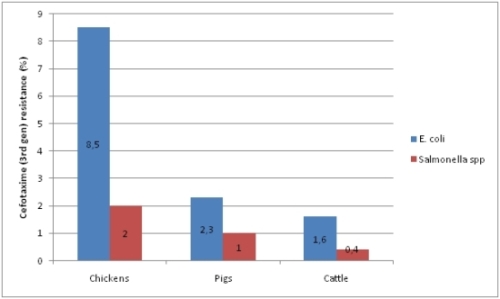Cephalosporin antibiotics: Control or ban?

The Panel of Biological Hazards (BIOHAZ) of EFSA has just published an opinion on the public health risks of bacterial strains (primarily E. coli and Salmonella species) producing extended-spectrum beta-lactamase (ESBL) enzymes or AmpC beta lactamases in food producing animals and food.
These enzymes cause resistance to 3rd and 4th generation cephalosporins, such as ceftiofur and cefquinome and are thought to be associated with their use in veterinary medicine. Similar antibiotics are of critical importance in human medicine, hence the concern of the spread of the resistance genes that produce these enzymes from animals to man. They are looking at possible control options i.e. to stop all uses of cephalosporins, systemically active cephalosporins (not those used for mastitis control), or systemically active 3rd and 4th generation cephalosporins only or to severely restrict their use.
Comprehensive report
This is a very comprehensive report and as well as highlighting the potential problems admits to weakness and deficiencies in the data. From a survey of a number of EU countries they have identified a potential hazard of ESBL and AmpC resistance genes being found in both E. coli and Salmonella species in animal production (see Figure 1).
Although the overall prevalence is generally low, in some countries, such as Spain and the Netherlands the incidence in chickens is quite high, 26.4 and 17.9%, respectively but only 1.1 and 3.7% in pigs. The highest recorded in pigs was in Hungary and Poland, both on 3.8% and in cattle in Hungary at 6.5%. These results are surprising in that chickens appear to have the main problem, thought to be due to injection of eggs and day old chicks but also due to the close pyramidal structure of the industry and the ease of vertical transmission of resistant organisms. In addition, the cephalosporins are no longer approved for use in chickens in the EU but are being used under the cascade and possibly could be better controlled.
Selection
The overall selection of these specific resistance genes is thought to be primarily associated with the use of 3rd and 4th generation cephalosporins but it was pointed out that the genes are commonly associated with other resistance genes to the more common, veterinary antimicrobials used and therefore general antimicrobial use is a potential risk factor. However, they also comment that the establishment of risk factors is complicated by the unavailability of supportive data or lack of its accuracy, as in this case.
Denmark and France have already voluntarily suspended the use of 3rd and 4th generation cephalosporins, what are your opinions on the best way forward to control this problem?











